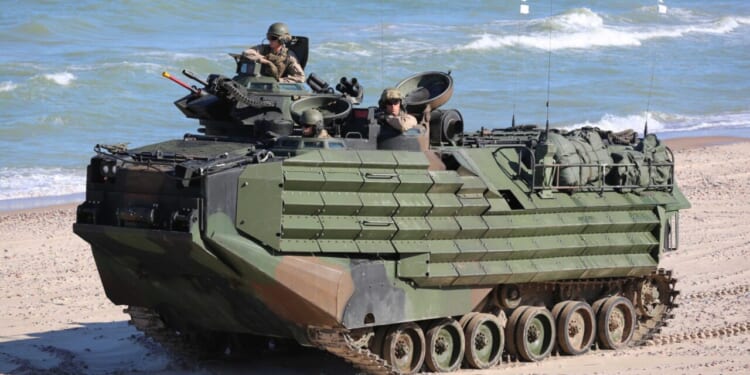The Marine Corps is pivoting back to the amphibious and fleet support roles that defined it during World War II.
The US Marine Corps is moving on from the long-serving Assault Amphibious Vehicle (AAV) after 53 years of service. Camp Pendleton, California’s Assault Amphibian School, held a ceremony and parade on September 26, marking the AAV’s official retirement. A Marine wearing an alligator costume stood in the hatch of one parading AAV, acknowledging the “Gator” nickname bestowed on tracked amphibious vehicles during World War II.
The original amphibious Landing Vehicle, Tracked (LVT or AMTRAC) entered service in 1943. The Marines had been clamoring for such a vehicle since the late 1930s, when American amphibious doctrine was hammered out in the Caribbean.
The coral reef at Tarawa’s Betio Island in November 1943 demonstrated the stark consequences of having insufficient LVTs on hand. Standard Higgins LCVP landing craft, despite their shallow draft, could not negotiate the low water level over the reef, forcing much of the Second Marine Division’s assault force to wade 800 to 1,000 yards through the lagoon under heavy Japanese fire.
The tracked LVT-1s and LVT-2s negotiated the reef and continued to the landing beaches, but thin armor made them vulnerable to artillery, mortar, and machine gun fire. Surviving LVTs tried to ferry wading Marines to the beaches with varying success. But the Gators lost 90 of 125 vehicles during the assault, forcing hundreds of Marines to make the bloody walk alone. Better armed and armored LVT-3s and LVT-4s became ubiquitous in the amphibious campaigns of 1944 and 1945.
Postwar Evolution
The Gators evolved through the years, with the Landing Vehicle, Tracked, Personnel-7 (LVTP-7) adopted in 1972. It was lighter and carried fewer Marines than its predecessor, the LVTP-5, but it was faster in the water and on land, with a greater range. The waterborne speed was provided by four rear water jets aiding the tracks, which had previously been the only means of propulsion. Armament was one M85 .50 caliber machine gun in a top-mounted turret. Special command (LVTC-7) and recovery (LVTR-7) variants also entered service.
The 1980s saw the LVTP-7s upgraded with new engines, transmissions, and water jet pumps. They were also redesignated as the Assault Amphibious Vehicle-7 (AAVP-7). The command and recovery variants received the same upgrades and were redesignated as the AAVC-7 and AAVR-7, respectively. A few years later, the Marines replaced the M85s with new M2 .50 caliber machine gun turrets, while adding the Mk 19 40mm automatic grenade launcher.
Decades of Service
The LVTP-7s served well in Lebanon and Grenada in the early 1980s. Exported models assaulted the Falkland Islands as part of the Argentine attack in 1982. The upgraded AAV fought in the 1991 Gulf War and a couple of years later in Somalia.
The early 1990s saw another significant upgrade with the Enhanced Applique Armor Kits (EAAK). The EAAK provided better protection against small arms fire and shrapnel from mortars and artillery. The AAV-A1 variant appeared later that decade, giving the vehicle the same engine as the US Army’s M2 Bradley Fighting Vehicle, as well as improved suspension.
AAVs invaded Iraq in 2003, where their relative lack of armor became a problem. Built for amphibious operations, the AAV was vulnerable to improvised explosive devices (IEDs), rocket-propelled grenades, and mortars, not least because of its open-top design. While some Marines extolled its value in Fallujah, the AAV was quite literally a fish out of water in a land-based desert campaign with few river crossings, but multiple urban scenarios. Extended wear in such an environment contributed to unreliability even when crossing rivers and canals, resulting in multiple sinkings.
A New Amphibious Assault Vehicle
Efforts to replace the AAVs began in 2012, and planned upgrades were canceled in 2018, when the Marines decided to develop a new platform. The AAVs were showing their age, with increased incident rates, including fires and sinkings. Eight Marines and one sailor were killed when their AAV sank during a 2020 training exercise off California’s San Clemente Island. The Marine Corps stopped deploying AAVs in 2021 and banned them from entering the water except in case of an emergency crisis response.
The new Amphibious Combat Vehicle (ACV) replaces the AAV and is now in service worldwide. The ACV features an 8×8 wheeled design instead of the familiar tracked vehicles. It offers significantly higher speeds on land, but less reliable performance on soft, sandy beaches. The ACV’s waterborne speed is similar to that of the AAV. The V-shaped hull makes it more resistant to mines and IEDs, and one variant sports a turret-mounted 30mm cannon. Like the AAV, the ACV also has command and recovery variants.
Times change, even for venerable fighting vehicles. The LVT design survived and thrived for seven decades, so long as it was performing the job for which it was intended. The Marine Corps is pivoting back to the amphibious and fleet support roles that defined it during World War II. The new ACV has a distinguished legacy to live up to in that mission.
About the Author: William Lawson
William Lawson is a military historian focusing on World War II and 20th century conflicts and the American Civil War. His specialty is operational level warfare, especially American amphibious doctrine. He writes on history, politics, and firearms for multiple publications and historical journals. He serves on the editorial advisory board for the Saber & Scroll Journal and Military History Chronicles and is a member of the Society for Military History and the American Historical Association. Lawson is based in Virginia.
Image: Wikimedia Commons.


















